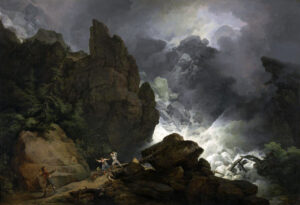Oddcast episode
February 8, 2023
Magic, Technology, Art, and Enlightenment: Gillian McIver on Philippe-Jacques de Loutherbourgh

Philippe-Jacques de Loutherbourgh (1740-1812) was the man.
Born in Strasbourgh, where he acquired a solid education in oil-painting but also in alchemy, along with an entrée into the very vibrant Occultist scene in that city at the time, he later moved to Paris, where he became the youngest member of the Académiein in 1767. Moving on to London, de Loutherbourgh revealed more sides to his many-faceted nature, inventing and presenting the Eidophysikon, a kind of mechanical proto-cinema, developing stage effects for David Garrick and later for the over-the-top party at Fonthill which gave rise to the writing of William Beckford’s Vathek (we forgot to get to Beckford in the interview, but that’s okay, since he deserves several episodes of his own). He knew everyone: Swedenborg (probably), Caglistro (for sure – they were good friends, until they weren’t), Beckford, and many other luminaries. He and his wife Lucy were actively-involved in many esoteric circles in London, enthusiastic sexual magicians, engaged in faith-healing practices of some kind in West London, and tried to spread esoteric Co-masonry to England.
I told you he was the man.
It was a pleasure to speak about de Loutherbourgh with Gillian McIver, an art-and-magic (or is that ‘art-as-magic’?) historian, enthusiast of de Loutherbourgh’s life and work, and delightful person.
 Interview Bio:
Interview Bio:
Dr Gillian McIver is a writer, art-historian, and filmmaker. Her published work includes the guidebook Art History for Filmmakers.
Recommended Reading:
The Bill Douglas Cinema Museum at the University of Exeter has a large collection of Loutherbourghenalia, but, sadly, no Eidophusikon.
Simon During. Beckford in Hell: An Episode in the History of Secular Enchantment. Huntington Library Quarterly, 2:269–88, June 2007.
John Gage. Loutherbourgh: Mystagogue of the sublime. History Today, 1963.
Iain McCalman. Magic, Spectacle and the Art of Loutherbourg’s Eidophusikon. In Ann Bermingham, editor, Sensation and Sensibility: Viewing Gainsborough’s “Cottage Door”, pages 181–89. Yale University Press, New Haven, CT, 2005a.
Idem. Spectres of Quackery: The Fragile Career of Philippe de Loutherbourg. In James Chandler and Kevin Gilmartin, editors, Romantic Metropolis: The Urban Scene of British Culture, 1780-1840, volume 3, pages 341–54. The University Press, Cambridge, 2005b.
Idem. The Virtual Infernal: Philippe de Loutherbourg, William Beckford and the Spectacle of the Sublime. Romanticism and Victorianism on the Net, 46, May 2007. URL https://doi.org/10.7202/016129ar.
Pratt, Mary. A List of a Few Cures Performed by Mr. and Mrs. de Loutherbourg, of Hammersmith Terrace, Without Medicine. At the Mary-la-bonne printing-office, No. 108, Great Titchfield-Street, Oxford-Street, by JP Cooke, for the author, and sold by W. Nicoll…, T. Parsons…, Smith and Gardner… and the booksellers in town and country, 1789.
A Few of de Loutherbourgh’s Paintings




Themes
Alchemy, Cinema, Co-masonry, Emmanuel Swedenborg, Freemasonry, George Gordon, Giuseppe Balsamo Cagliostro, Illusion, Interview, Magic, Medicine, Mesmerism, Occultism, Philippe-Jacques de Loutherbourgh, Sexual Magic


Steve Dempsey
March 8, 2023
de Loutherbourgh and friends get a mention in this entertaining lecture by Paul Monod, author of a recentish book Solomon’s Secret Arts: The Occult in the Age of Enlightenment (2013).
https://archive.org/details/mcdla_PaulMonod111406
Steve Dempsey
May 21, 2023
I had a poke around and found the bill of sale for de Loutherbourg’s estate after he died in 1812. This includes his painting, his objets d’art (many weapons!), pieces of his stage work, some scientific instruments, and quite a long list of books, including the esoteric.